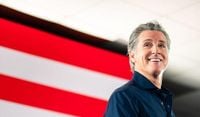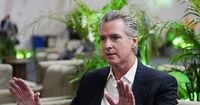California Governor Gavin Newsom has catapulted into the national spotlight as the early frontrunner for the 2028 Democratic presidential nomination, according to a series of recent reports and political analyses. Over the past two years, Newsom has deftly maneuvered through the shifting sands of party politics, leveraging both traditional experience and digital savvy to position himself as a leading contender for the White House. But as his profile rises, so do questions about the breadth and depth of his appeal within a party increasingly divided along ideological lines.
Politico senior political columnist Jonathan Martin was among the first to declare Newsom the Democratic Party’s “front-runner” for 2028, noting, “No Democrat has had a better two years than Gavin Newsom and because of it, the California governor — a national figure since he was a 36-year-old boy mayor — has claimed a new title: front-runner.” Martin’s column, published November 16, 2025, underscored Newsom’s unique blend of old-school political credentials and modern media prowess. He drew comparisons to Jimmy Carter, Bill Clinton, and Barack Obama, all of whom emerged as youthful, outsider candidates capable of challenging the Washington status quo while still reassuring party insiders.
“By the old rules of Democratic nominations, Newsom fits neatly in the tradition of Jimmy Carter, Bill Clinton and Barack Obama: younger, outsider candidates who could credibly run fresh campaigns against the Washington status quo of both parties while claiming enough insider credentials to reassure party mandarins who care about such things,” Martin wrote, as cited by Politico. But Martin also emphasized that Newsom is “the best-positioned Democrat according to the new rules of politics — namely, whether you are or can become famous by breaking through on social media.”
Newsom’s digital acumen has been on display in his frequent, sometimes irreverent, jabs at former President Donald Trump. According to Politico, Newsom’s willingness to mock Trump and his supporters online, even using AI-generated content, has “endeared him to the sprawling anti-Trump coalition, even the Newsom skeptics among them.” This has been especially salient since Trump, after winning the 2024 election, deployed the National Guard and active-duty Marines into Los Angeles to quell protests over immigration enforcement, a move that Newsom publicly opposed.
Newsom’s political foundation is not built solely on social media theatrics. As reported by Breitbart and Politico, he maintains longstanding ties to national Democratic figures such as Bill Clinton and Nancy Pelosi, and his early participation in the Clinton Global Initiative signaled his ambitions and networking skills. In September 2025, former President Bill Clinton told Politico sources that Newsom “has what it takes to be elected president,” while another California political heavyweight, Willie Brown, dubbed him “big time” and “the movie star.”
But perhaps Newsom’s most consequential recent move was his support for Proposition 50, a ballot initiative that allows California’s Democrat-controlled legislature to redraw congressional districts mid-decade, overriding the independent commission established by voters in 2008. The measure, which passed overwhelmingly on November 4, 2025, is projected to net Democrats up to five additional U.S. House seats. Newsom’s gamble to have voters approve a redistricting overhaul—seen by some as a counter to Republican moves in Texas—was called as the polls closed, and he took a victory lap on election night.
Yet even as Newsom basks in media praise and the endorsement of party elders, internal Democratic Party research reveals a more complicated picture. According to data from Future Forward, the party’s top super PAC, it was not Newsom but Rep. Alexandria Ocasio-Cortez (D-NY) who delivered the most effective message in support of Proposition 50. Her direct-to-camera ad, including a Spanish-language version, outperformed all others, boosting support for the measure by more than five percentage points. The ad resonated by linking redistricting to everyday concerns like health care, wages, and personal freedoms, and aired primarily on digital platforms.
This revelation has fueled speculation about Ocasio-Cortez’s own ambitions. Axios reports her team is already positioning her for a potential 2028 presidential or Senate run. While she currently trails Newsom and Kamala Harris in early polls, she placed third among Democratic voters with 8% support in a recent Noble Predictive Insights poll, ahead of several other potential candidates. An Emerson College poll from earlier in 2025 also showed her trailing Vice President JD Vance by just three points in a national matchup, with Newsom similarly close behind Vance.
Meanwhile, Newsom’s centrist and inclusive rhetoric has become a hallmark of his campaign style. He has repeatedly stated his vision for a Democratic Party that spans its ideological spectrum. “I want it to be the Manchin to Mamdani party. I want it to be inclusive,” he told Politico, referencing both centrist Joe Manchin and progressive Zohran Mamdani. Newsom often describes himself as a “hard-headed pragmatist” and resists being labeled ideologically. “Once a mayor, always a mayor—get things done,” he told Jonathan Martin, adding, “I don’t want to be labeled. I find it reductive.”
This positioning may be strategic, as the Democratic Party’s two main factions—progressives and centrists—remain deeply divided. As The Atlantic observed, “the idea that one of the two main party factions, the progressives and the centrists, will vanquish the other in the 2028 presidential primary process seems fanciful.” The article continued, “Democrats are too splintered internally to accept the dominance of either the progressive faction or the centrist faction. The winner therefore will likely be a non-factional figure who is younger and capable of making a sharp case against the Trump administration with a platform that offers just enough to everyone in the party to keep them focused on who and what they dislike the most.”
Recent polling supports Newsom’s rise. According to YouGov data cited by The Atlantic, the share of Democrats and Democratic-leaning independents who say they would consider voting for him as the nominee in 2028 has risen 24 percentage points, to 55 percent from 31 percent, since April. The share who say he is their ideal candidate has increased 16 points, to 23 percent from 7 percent.
Still, Newsom faces significant challenges. The California Republican Party has filed a federal lawsuit against Proposition 50, alleging that it violates the 14th and 15th Amendments by unconstitutionally gerrymandering congressional districts. At a press conference, State Assemblyman David Tangipa declared himself the lead plaintiff, joined by party chairwoman Corrin Rankin and attorney Mike Columbo. Eighteen California voters have also joined the suit, arguing the new map favors one racial group over others. Newsom’s office, however, has predicted the lawsuit will not succeed.
As the 2028 race takes shape, Newsom is also preparing to release a memoir in February 2026—a rite of passage for presidential hopefuls. His next moves will be closely watched, not only by supporters and detractors within the Democratic Party, but by a national electorate eager to see who will emerge to challenge a resurgent Trump and a divided Republican Party.
With the Democratic field still wide open and the party’s internal divisions unresolved, Newsom’s ability to straddle ideological lines, embrace digital politics, and position himself as the face of the anti-Trump “Resistance” may prove decisive. For now, he stands as the candidate to watch—at least until the next twist in America’s ever-unpredictable political drama.

